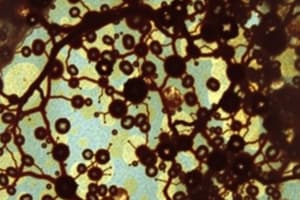Podcast
Questions and Answers
Which of the following is NOT true about prokaryotic cells?
Which of the following is NOT true about prokaryotic cells?
- They have a cell wall made of peptidoglycan.
- They lack a nucleus.
- They have ribosomes that are smaller than those found in eukaryotic cells.
- They have a complex internal structure with many membrane-bound organelles. (correct)
Who is credited with improving the microscope and making discoveries like bacteria and yeast?
Who is credited with improving the microscope and making discoveries like bacteria and yeast?
- Matthias Schleiden
- Robert Hooke
- Theodor Schwann
- Antony van Leeuwenhoek (correct)
The cell theory states that all living things are composed of one or more cells. What is the other key principle of this theory?
The cell theory states that all living things are composed of one or more cells. What is the other key principle of this theory?
- Cells can spontaneously generate from non-living matter.
- All cells have the same basic structure and function.
- Cells can only be seen with a microscope.
- Cells are the basic unit of structure and function in living things. (correct)
What is the primary function of ribosomes in a cell?
What is the primary function of ribosomes in a cell?
Which of these structures is NOT found in all prokaryotic cells?
Which of these structures is NOT found in all prokaryotic cells?
What is the function of the capsule in some prokaryotic cells?
What is the function of the capsule in some prokaryotic cells?
What is the main difference between prokaryotic and eukaryotic cells?
What is the main difference between prokaryotic and eukaryotic cells?
Which of the following is an example of a prokaryotic organism?
Which of the following is an example of a prokaryotic organism?
Flashcards
Cell
Cell
The smallest unit of composition and function in living organisms.
Microscope
Microscope
An instrument that magnifies objects to study small structures like cells.
Cell Theory
Cell Theory
All living organisms are composed of cells; cells are basic units of life; new cells arise from existing cells.
Plasma Membrane
Plasma Membrane
Signup and view all the flashcards
Cytoplasm
Cytoplasm
Signup and view all the flashcards
Prokaryotic Cell
Prokaryotic Cell
Signup and view all the flashcards
Eukaryotic Cell
Eukaryotic Cell
Signup and view all the flashcards
Cell Wall
Cell Wall
Signup and view all the flashcards
Study Notes
Cytology - Part 1
- Cytology is the study of cells.
- Cells are the basic building blocks of all living organisms.
- Some organisms are made of one cell, others have many.
- Cells vary in size and cannot be seen with the naked eye.
- Microscopes are used to study cells.
- A microscope magnifies an object.
- Images from a microscope are called micrographs.
- Antony van Leeuwenhoek invented a microscope in 1591.
- He observed yeast, bacteria, blood cells, and tiny animals in water using his improved microscope.
- Cells are the smallest unit of living organisms with a function and composition in living organisms.
Cell Theory
- Matthias Schleiden and Theodor Schwann proposed the unified cell theory.
- All living things are composed of one or more cells.
- The cell is the basic unit of life.
- New cells arise from existing cells.
Basic Structures of a Cell
- Cell membrane: Separates the cell's interior from its environment.
- Cytoplasm: Jelly-like material inside the cell.
- DNA: Genetic material of the cell.
- Ribosomes: Synthesize proteins.
Types of Cells: Prokaryotic
- Simple cells, like bacteria and archaea.
- Mostly unicellular organisms.
- Lack nucleus and membrane-bound organelles.
- DNA is located in a region called the nucleoid.
- Have cytoplasm and ribosomes (70s).
- Have cell membranes.
- Most have a cell wall made of peptidoglycan.
Types of Cells: Eukaryotic
- Complex cells, like animals, plants, fungi, and protists.
- Have a true nucleus and membrane-bound organelles.
- Have several rod-shaped chromosomes.
- Have cytoplasm and large ribosomes (80s).
- Have cell membranes.
- Plant cells have a cell wall made of cellulose.
- Some have flagella for locomotion.
Cell Wall (Prokaryotic)
- Provides protection.
- Maintains cell shape.
- Prevents dehydration.
- Some have a capsule made of polysaccharide.
- The capsule can help cells attach to surfaces.
- Some prokaryotes have flagella for locomotion.
- Some have pili for exchanging genetic material (plasmid transfer) during conjugation (a type of reproduction).
Eukaryotic vs. Prokaryotic cells (Summary)
| Feature | Eukaryotic | Prokaryotic |
|---|---|---|
| Nucleus | True nucleus | No true nucleus |
| Organelles | Membrane-bound organelles | No membrane-bound organelles |
| Ribosomes | Large (80S) | Small (70S) |
| Cell wall | Cellulose (in plants) | Peptidoglycan |
| Flagella/Pili | (9+2) arrangement | Single microtubules |
| Cell size | Large (10-100µm) | Small (0.3-5µm) |
Studying That Suits You
Use AI to generate personalized quizzes and flashcards to suit your learning preferences.




